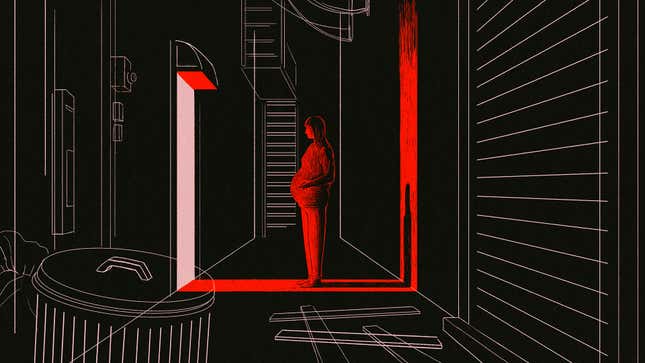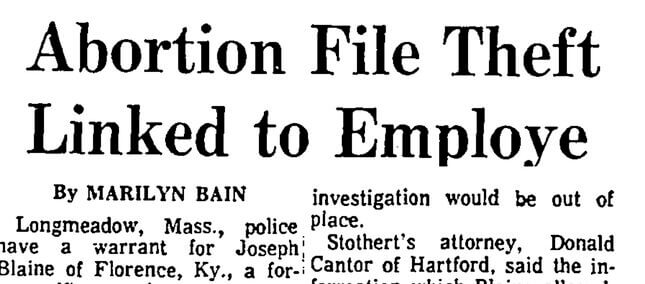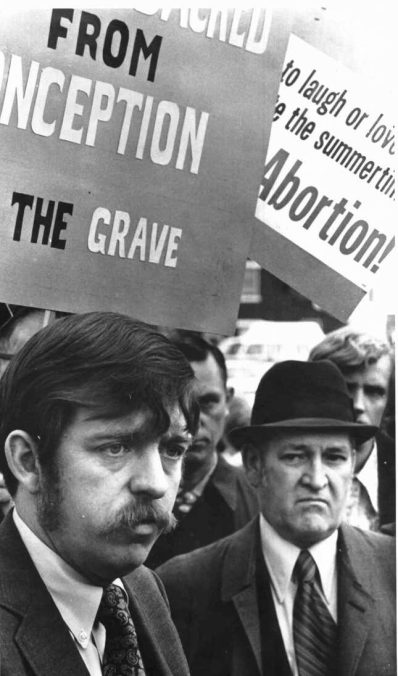
Illustration: Angelica Alzona/GMG
Last summer, I received the first of a string of emails from Joseph Blaine, a man who wanted to share his story with me: despite his lack of medical training, in the decade before Roe v. Wade, he provided illegal abortions. “I am most eager to confess,” Blaine’s first email read, “just how bad it was, with infections, perforations, and deaths of women [and] children.”
Blaine performed illegal abortions during the 1960s and early 1970s before the Supreme Court legalized abortion. As abortion laws changed, so did Blaine’s business tactics and the language he used to market his services. More than this, Blaine’s career spotlights the varied dangers American women faced before and after legalization.
Blaine did not have any formal medical training. During the 1960s and early 1970s, Blaine was what was commonly known as a “back-alley butcher,” an unskilled and untrained abortion provider that operated on women and, as Blaine told me, injured them. In 1970, Blaine worked for and then operated an abortion referral service, sending women to providers in England and New York state after these jurisdictions legalized abortion. Finally, from Roe until the late-1970s, he operated abortion clinics in the Midwestern United States.
Before the passage of Roe, women with unwanted pregnancies had limited options. They could bear the unwanted child and choose to keep it or give it up for adoption. Women with financial means and connections could try to secure a safe but illegal and usually expensive abortion from a skilled physician. Women with fewer resources, despite the long odds against approval, might choose to ask for a therapeutic hospital abortion. Some women might try to find the funds for a trip abroad where abortion was more accessible. A number of women attempted to self-abort using home remedies or dangerous instruments. In the background, there were always “back alley” providers who had questionable training and motives.
In the 1950s, researchers estimate that anywhere between 200,000 and 1.2 million women sought illegal abortions per year. By the mid-1960s, demographers placed the number at 800,000 annually. A significant percentage of these thousands of women ended up in hospitals for health complications caused by botched and unsanitary abortion. A 1964 article in California Medicine detailed the variety of methods illegal abortionists used:
Intrauterine injections of soap or of peroxide; insertion of coat hangers, knitting needle or welding wire; insertion of air by catheter or by a plaster straw, using a football pump; douches of lysol, soap or potassium permanganate; ingestion of ergotrate, turpentine, magnesium sulfate, castor oil, or of a potassium compound.
A 1970 article hinted at the frightening extent of the medical complications from illegal abortion; it described how Cook County Hospital in Chicago managed over 20,000 illegal abortions between 1961 and 1965 alone. Doctors there treated women for complications stemming from those abortions, including uterine tears and sepsis. Sensational newspaper headlines, meanwhile, regularly alerted Americans to abortion fatalities, but under-reporting and misreporting by hospitals and coroners make it impossible to know the full scale of fatalities caused by illegal abortion.
The already-married 25-year-old Blaine and his 17-year-old girlfriend inhabited this legal and medical landscape in 1965 when she became pregnant. It’s unclear what medical options existed for them in Lexington, Kentucky but Blaine decided to take matters into his own hands. He learned how to perform the operation himself.

“A [veterinarian] taught me,” Blaine said, “using his collie!” He described practicing on the collie as well as livestock. Blaine’s teenage girlfriend became his first human patient, and he successfully caused her to miscarry using an intrauterine device.
Between 1965 and 1969, Blaine worked as a fireman in Lexington, Kentucky. He quickly found a ready supply of women for his services. Blaine said that he operated on these pregnant women in “the hose towers” of the firehouse where he worked or in “or vehicle back seats in stations’ back alleys.” Blaine remembers how these poor women paid for his services: “Sometimes it cost the woman a hundred, sometimes 50, and sometimes I traded the abortion for an occasional stereo, antiques, or sexual favors.” Historian Leslie Reagan explains that this sexual exploitation—what Blaine called trading abortion for “sexual favors”—occurred frequently. “Abortionists,” Reagan writes, “took advantage of their clients’ vulnerability… to sexually harass and exploit them. These men equated abortion with sexual availability.”
Although Blaine’s illegal enterprise expanded, he never became an expert at performing abortions. Women he operated on got infections and uterine perforations. In 1973, one woman told the Courier-Journal in Louisville, Kentucky that Blaine botched her abortion and nearly killed her. After he used an intrauterine device to induce her abortion, she said that she hemorrhaged for over a week before seeking treatment at a local hospital. Blaine confirmed the story and told the Courier-Journal, that “she had a pretty bad time.” He added: “The things I did not know as a layman were the things that caused her to have a bad time.” He then shifted the blame, adding that the woman had pre-existing medical conditions caused by two previous illegal abortions.

Like so many women who went to pre-Roe providers, Blaine’s clients were reluctant to seek medical help or file criminal complaints. Shame about getting pregnant, as well as the knowledge that they had broken the law, kept many women silent. Fear and guilt were also powerful persuaders. To protect himself from criminal complaints, Blaine said he offered women a cheaper price if her boyfriend, mother, friend or relative took part in the operation. By implicating someone close to the woman in a criminal act, “she would be reticent to turn me in, if she was unsatisfied with the job, later,” he said.
As Blaine’s abortion business boomed, discussions about abortion regulations expanded throughout the United States, Canada, and England. Numerous American state legislatures debated whether to modernize century-old abortion laws as Mainline Protestant and Reform Jewish denominations spoke out in favor of humane abortion laws. Major magazines like Life and Time, and newspapers like the New York Times, the Chicago Tribune and the Los Angeles Times spotlighted the dangers of back-alley abortionists while spotlighting the dangers to women who managed to sidestep the law. The media also covered the activities of groups that challenged abortion laws and helped women obtain safe abortions like the Society for Humane Abortion, the Clergy Consultation Service, and the feminist collective Jane. Police and district attorneys, meanwhile, continued to investigate and arrest illegal abortion providers, especially when their trade injured or killed women.
In 1968, the Lexington, Kentucky police arrested Blaine after he botched an abortion on a client—the local newspapers described her as “a young girl,” but her age is unclear—who was about five months pregnant, leading to her hospitalization. Blaine had inserted an intrauterine device into the “young girl” causing her, according to court records, to become “violently ill,” miscarry and require hospitalization. A newspaper report at the time of his arrest noted that the woman was in satisfactory condition after receiving treatment.
At Blaine’s 1969 trial, the woman testified against Blaine and reported that he actively sought her out to offer his services. A jury found Blaine guilty of performing an abortion and sentenced him to two years in prison. It took Blaine’s lawyers nearly two years of legal wrangling to successfully appeal his conviction on a technicality. In 1971, Blaine faced a re-trial on an amended charge of attempting to commit a felony. This lesser charge arose because Kentucky abortion laws were in flux—prosecutors told the Lexington Kentucky Leader that the laws were in “a considerable state of confusion”—and because prosecutors could not locate the woman upon whom Blaine performed the abortion to testify. In the end, Blaine pleaded guilty to the lesser charge and was fined $1000.
As his case wound its way through the courts, Blaine continued with his abortion enterprise, moving his trade to more mobile locations to evade prosecution. Boats and small aircraft, he claimed, became his operating theater. Blaine said that he sometimes hired medical students to perform the abortion while he flew the plane. In 1973, he told the Courier-Journal that he took “young gyn doctors” on his plane, “letting them perform abortions in the air.”
Legislative reforms to abortion laws rapidly shifted the illegal abortion trade. A number of states loosened their regulations in the late 1960s. The shift came when England (1968) and New York (1970) liberalized their laws and allowed non-residents to access abortion services in-state. This absence of residency requirements led to a large, lucrative and unregulated abortion travel industry as women with unwanted pregnancies and means sought medical aid.
Blaine also stepped into the booming abortion travel industry. In 1970, Blaine began working for an abortion referral service known as the London Agency. Initially based in Springfield, Massachusetts, with branch offices in Boston and Hartford, Connecticut, the London Agency offered a package travel deal. For the price of $1250, the service included air transportation, expedited assistance obtaining passports, health certificates, hotel accommodations, and abortions in a private London hospital. The historical record isn’t clear on which doctors in England saw the London Agency’s clients or the quality of care they received. Reports in the Guardian and the Hartford Courant underlined that some British politicians feared that an organized influx of Americans would overtax the British medical system. Blaine claims that some patients returned home from England “needing hospitalization for retained tissue, or infections, or both.” Still, the demand for abortion travel was high and profits, according to Blaine, were astronomical. “We took in millions in 4 mos [sic],” Blaine recalled.
Political pressure quickly mounted against the London Agency. Prosecutors in Massachusetts brought charges against the business for advertising abortion services and for forging its articles of incorporation. On the other side of the Atlantic, British politicians sought to prevent doctors from working with the London Agency. As Massachusetts prosecutors subpoenaed the London Agency’s files, Blaine stole the patient files from his employers. Blaine’s theft made headlines in the Hartford Courant and the Washington Post. In February 1970, the Courant reported that a warrant was issued for Blaine’s arrest on the charge of “larceny under $100.” The Courant story added that a spokesperson for the London Agency accused Blaine of using the “records for extortion attempts in phone calls made from Kentucky.” Blaine said he used the files to contact the women who could not afford the agency’s steep price. He claimed that he turned a quick profit offering illegal abortions to these women out of a hotel room near Boston.

By the time New York legalized abortion in mid-1970, the London Agency had become obsolete. New England women seeking abortions increasingly arranged their own travel to New York state. Blaine’s business also evolved. He moved to Ohio and started a new abortion travel venture—Aeromedic. For about $450, Blaine flew midwestern women to western New York for abortions. Blaine told me that he would offer free flights to poor women in exchange for their promoting his service by word of mouth.
His marketing for Aeromedic was shameless. Unable to purchase advertisements in local papers or on billboards, Blaine claimed he would have his own “pre-teen kids, and former very young patients” accompany him to local sports games. These children would stand near the top rails of the stadium. At the first touchdown or home run, they’d “blanket the fifty thousand patrons showering the crowds with thousands of small flying cards as if confetti,” Blaine said. He added that phones would start to ring by the end of the day requesting his services.
After the Supreme Court decided Roe v. Wade in 1973, abortion travel quickly waned as clinics opened up across the United States. States rushed to regulate this newly legal procedure and a greater degree of oversight and regulation emerged. Blaine opened up his own clinic and quickly appropriated abortion rights rhetoric. He called his first clinic in Covington, Kentucky “Choice” and described his work as “part of the freedom struggle for women.” Local authorities, keen to regulate clinics, immediately pushed back and their persistent investigations forced Blaine to move across the Ohio River to Cincinnati within three months. Blaine said that his Kentucky clinic “botched jobs” and left his patients with “life-threatening conditions.”
In Ohio, Blaine named his second clinic the “Women’s Health Care Center” and advertised with flyers with the motto “Now There is a Way.” Not long after this clinic opened The Cincinnati Enquirer reported on rumors “that if someone comes to Blaine for an abortion and lacks the money to pay for it, he takes his compensation in other ways.” Blaine denied this rumor to the reporter at the time. He operated the “Women’s Health Care Center” for several years down the street from a Planned Parenthood. Blaine, however, found himself facing difficulties obtaining insurance coverage for his business because of accidents, losses, and claims. He shared a letter with me from one insurer who cited his religious beliefs as a reason for denying Blaine coverage. Blaine said he left the abortion trade in 1978 because of these difficulties, as well as an expensive lawsuit. A patient sued Blaine and one of his physicians after a botched abortion left her, according to the lawsuit, “septic” with “necrotic pieces of placenta… floating free in the abdominal cavity.” As a result, the patient was forced to have a hysterectomy. In the early 1980s, Blaine’s former clinic found its way into the news in 1985 after an anti-abortion protester firebombed it and the Planned Parenthood down the street.

Blaine’s story is as haunting as it is frighteningly relevant; though extraordinary, his career is not exceptional. There were countless unskilled men and women like Blaine who exploited those seeking to end their pregnancies. But his story raises hard questions about what will happen if the Supreme Court overturns or further interferes with abortion rights—a scenario that seems increasingly likely with the pending confirmation of Brett Kavanaugh. Blaine’s story matters because it tracks with how criminalization and legalization shifted abortion provision. It’s also a persistent reminder of what women had to go through before Roe, as well as the perils that could reemerge if the landmark ruling is overturned. Criminalization does not stop abortion—it creates a public health crisis by pushing women into contact with predatory, unqualified providers willing to profit off desperation.
Four states—Louisiana, Mississippi, North Dakota and South Dakota—currently have trigger laws that will make abortion illegal if the Supreme Court overturns Roe. The Center for Reproductive Rights estimates that 22 states are likely to ban all abortion. These numbers, however, do not measure the human cost of a healthcare disaster in the making.
Joseph Blaine contacted me because he wanted someone to tell his story so that he could find fame and fortune in his old age. He described himself as a “vagilante” [sic] acting on behalf of women’s best interests. (In past coverage, he framed himself in a similar manner, presenting himself as a kind of crusading pioneer of reproductive rights.) I broke off contact with him because I couldn’t tell his story on his terms. I did not want to help him profit further from activities that wounded so many women. Blaine’s career as an abortionist, as with his reason for contacting me, struck me as a testament to his self-interest. Though he professed contrition and claimed he sought absolution, in our correspondence and in conversation, he seemed to revel in his sexual exploitation, as well as his craft and wit in getting around the law. (Blaine did not respond to multiple requests for additional comment on this story.)
As Blaine closed one of his emails to me: “I have the bloodiest parts of my trail to explain for your further understanding of it all.” For those who seek to learn from the past, the bloodiest parts of Blaine’s trail can be explained in a few simple words: If abortion becomes a crime once more, women will again suffer.
Gillian Frank is co-host of the “Sexing History” podcast and a postdoctoral research fellow at University of Virginia’s Program in American Studies.